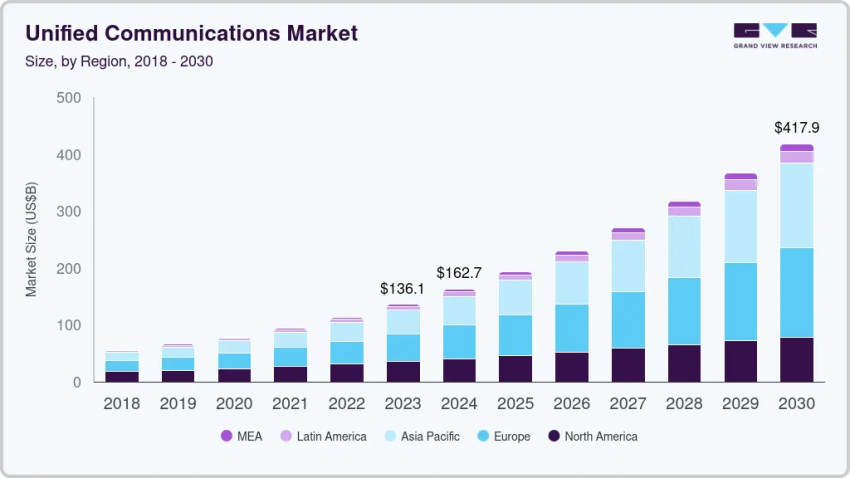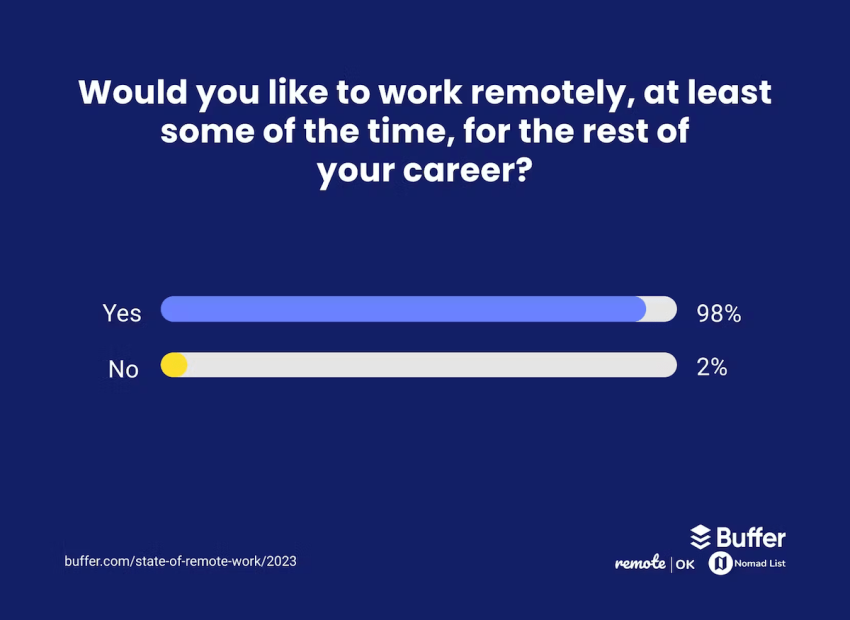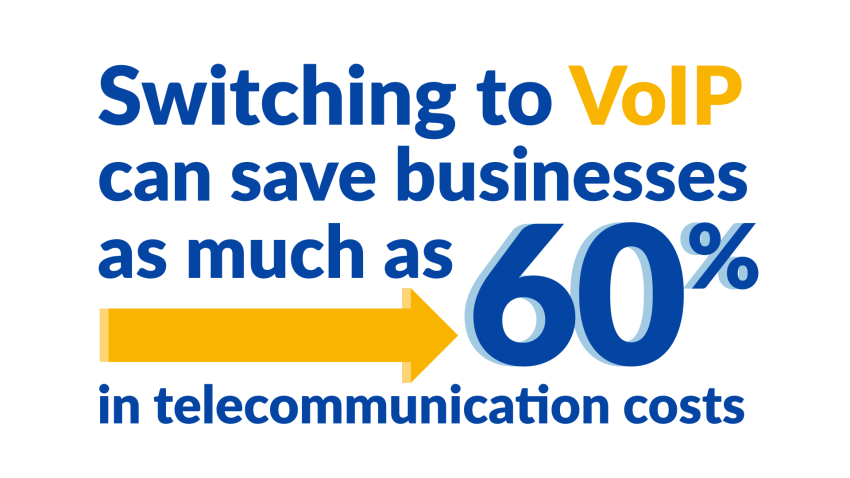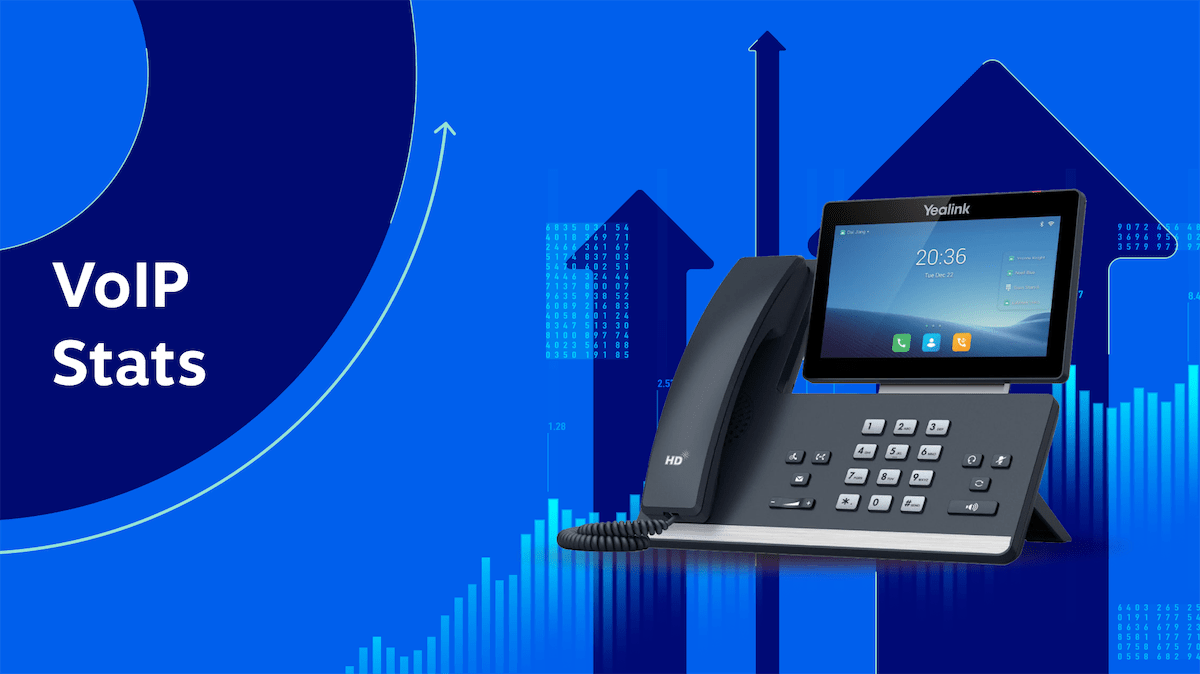Business communications have undergone rapid and profound changes. Traditional landline connections, with their tangled cables and physical limitations, are officially a thing of the past. Since 2004, the decline of the Public Switched Telephone Network (PSTN) has been unstoppable, making way for a more flexible, powerful, and cost-effective successor: Voice over Internet Protocol (VoIP).
Modern VoIP is no longer just a replacement for landlines, it’s the backbone of unified, AI-enabled customer experience. Nextiva’s 2025 CX research shows 92% of organizations have already adopted AI in CX, but most are still early in maturity, creating a clear opportunity for IT leaders to modernize communications with fewer tools, better uptime, and smarter routing. This refreshed guide breaks down the most relevant VoIP statistics shaping IT roadmaps for 2026.
To show why the move to VoIP and modern business communications technology isn’t just a fad, but a major shift in mindsets and the way businesses operate, we’ve compiled over 50 key VoIP statistics. This data highlights VoIP’s explosive market growth, the tangible financial benefits associated with it, and what the future of communications — powered by cloud and conversational AI — will look like.
Key VoIP Statistics (At a Glance) for 2026
Short on time? Here are the key VoIP statistics that show why businesses are switching to cloud communications:
- Massive savings for startups: New businesses can reduce their initial communication costs by up to 90% by choosing VoIP instead of traditional hardware-based phone systems. (Startup NZ)
- Daily productivity gains: Implementing a unified communications (UCaaS) platform saves employees an average of 30 minutes per day, leading to significant efficiency and performance improvements. (Network World)
- Meet customer demands: 56% of customers switch support channels when responses are slower than expected, reinforcing the need for unified VoIP and omnichannel routing. (Nextiva Customer Patience Benchmark)
- The AI expansion: By 2026, conversational artificial intelligence (AI) deployments in contact centers are expected to reduce agent labor costs by $80 billion. (Gartner)
1. VoIP Market Size and Unstoppable Adoption

VoIP first gained popularity in the 1990s and began to see impressive growth by 2005. Its market growth shows no signs of slowing down, especially as remote work becomes more commonplace and businesses seek solutions to support their distributed teams.
The following statistics illustrate that VoIP is no longer an alternative but the default choice for businesses:
- The global VoIP market was valued at $132.47 billion in 2023 and is forecasted to grow from $144.77 billion in 2024 to $326.27 billion by 2032, growing at a compound annual growth rate (CAGR) of 10.8% during the forecast period. (Fortune Business Insights)
- The broader Unified Communications (UC) market, which includes VoIP, is set to grow at a CAGR of 17.4% from 2023 to 2030. (Grand View Research)
- The global UCaaS market is expected to grow to more than 131 million users by 2028. (Telecoms Tech News)
- One example of the decline of old technologies is the fact that by the end of 2022, 73% of American adults and 83% of children lived in a household without a landline — a number that has tripled since 2010. (National Center for Health Statistics)
- When choosing a new voice service, businesses pick VoIP far more than any other option. 36% of software buyers choose VoIP, compared to just 24% for traditional plain old telephone services (POTS). (Software Advice)
- The main reasons for seeking new phone solutions are a lack of scalability, outdated systems, and the high costs of the current configuration. (Software Advice)
- The market for cloud-based contact center infrastructure based on VoIP technology is expected to grow by 26% between 2024 and 2029. (Mordor Intelligence)
- 90% of businesses will adopt a hybrid cloud approach through 2027. (Gartner)
2. The Cloud and UCaaS Shift

The switch to VoIP is part of a larger migration: the move to the cloud. Unified Communications as a Service (UCaaS) integrates phone, video conferencing, team chat, and file sharing into a unified cloud platform. This eliminates fragmented tools, increasing productivity and security gains.
- A large 82% of businesses reported significant cost savings as a direct result of cloud migration. (Microsoft)
- By 2025, 85% of businesses are expected to adopt the cloud-first principle and develop processes that are only possible thanks to the flexibility of this technology. (Gartner)
- Moving to the cloud brings many security benefits: 94% of companies report an improvement in their security posture after migration. (RapidScale)
- As of 2023, 50% of large businesses already have critical workloads in the cloud, with digital transformation (63%) being a key driver. (Statista)
- Even government agencies are already embracing the cloud: Almost half of government organizations use cloud services to increase efficiency and reduce costs. (Gartner)
- Implementing UCaaS saves employees an average of 30 minutes per day by centralizing communication and streamlining workflows. (Network World)
- Businesses using an integrated UCaaS platform report a 30% cost reduction for their conferencing tools alone. (Network World)
- Improved collaboration is a key outcome: 75% of UCaaS users report increased employee productivity. (Frost & Sullivan)
3. VoIP Powering the Remote and Hybrid Workforce

Remote and hybrid work wouldn’t be possible without VoIP and UCaaS. These technologies enable distributed teams to stay connected, collaborative, and productive, regardless of their location.
- In the US alone, over 4.7 million people now work at least half their working hours from home. (Apollo Technical)
- Contrary to some beliefs, remote workers are highly productive. They work an average of 1.4 more days per month (or 16.8 more days per year) than their office-based colleagues. (Airtasker)
- Remote workers often work longer hours. According to one study, they are 43% more likely to work over 40 hours per week than on-site employees. (Owl Labs)
- Modern work environments are multi-device. 59% of business professionals use at least three different devices for work communication. (Nextiva)
- A mobile VoIP app for businesses is essential. 87% of professionals use a mobile phone for work communication at least once a week. (Nextiva)
- Demand for flexible work continues unabated: 98% of employees want the option to work from home for the rest of their careers. (Buffer)
- Companies are listening. 74% of US businesses currently use a permanent hybrid work model or plan to implement one. (Zippia)
4. The Financial Impact and Cost Savings of VoIP

While cost reduction is the first benefit businesses notice, the actual financial impact of VoIP is much broader. It reduces startup costs, minimizes communication-related losses, and increases productivity, resulting in a high return on investment.
- Businesses can reduce their monthly phone bills by up to 50% by switching from landlines to VoIP. (TelZio)
- For new businesses, VoIP can reduce initial communication costs by up to 90% because it eliminates the need for expensive on-site hardware. (Startup NZ)
- Poor communication is extremely costly. 60% of professionals experience a business crisis due to communication problems at least once a month, and 14% report this happening weekly. (Nextiva)
- These mistakes have serious consequences. 83% of companies report losing customers, missing deadlines, or laying off employees due to communication issues. (Nextiva)
- By moving their contact center to the cloud, companies can reduce associated call handling costs by an average of 15%. (TTEC)
- VoIP also opens up new revenue opportunities. 60% of smartphone users have called a business directly using the “Click to Call” button in a Google search — a feature easily managed with VoIP numbers. (Google)
- Using toll-free VoIP numbers can increase a brand’s credibility and national presence, and can directly impact inbound sales lead generation. (Knowlarity)
5. VoIP Improving the Customer Experience (CX)

Customers want fast, reliable, and seamless customer support. VoIP and cloud contact centers offer the advanced features needed to meet these demands and turn customer service from a cost center into a driver of customer loyalty.
- The phone remains the preferred channel for short-term concerns. 54% of customers prefer solving their issues via phone compared to other channels. (Statista)
- Customer expectations are higher than ever. 51% of customers say a company must be available 24/7 in some form. (Influx)
- The stakes are high. 61% of customers have permanently terminated a relationship with a company after just one bad customer service experience. (Microsoft)
- Customers expect a seamless customer experience. 86% of customers expect a smooth transition between channels without having to repeat information. (MarketSplash)
- VoIP analytics are groundbreaking. Businesses that use contact center analytics have reduced their average handle time (AHT) by 40% and resolved issues faster. (McKinsey)
- 76% of calls from unknown numbers go unanswered. This highlights the need for VoIP features like branded caller ID. (Hiya)
- Conversely, 65% of calls are answered when a legitimate company name appears on the caller ID. (Hiya)
6. AI in Voice

Artificial intelligence (AI) is being integrated directly into VoIP and UCaaS platforms to make communications smarter and more efficient. From call transcription to sentiment analysis, AI supports agents and automates routine tasks.
- By 2026, one in ten agent interactions will be automated and AI-based, including chatbots, virtual assistants, and AI-guided calls. (Gartner)
- The financial impact will be enormous. Conversational AI is expected to reduce enterprise labor costs by $80 billion by 2026. (Gartner)
- AI is already improving contact centers. Over 67% of AI decision-makers plan to invest in generative AI to better understand customer needs and sentiment. (Forrester)
- AI-powered virtual agents can now resolve 70% of routine customer inquiries without human intervention and save an estimated $5.50 per call. (IBM)
- By 2027, roughly one in four organizations will rely on chatbots as their primary channel for customer service. (Gartner)
- AI sentiment analysis can identify frustrated customers in real time with 80%-90% accuracy and enable immediate routing to a human agent. (Lexalytics)
- Despite the rise of AI, 71% of people still prefer human interaction for complex issues. This highlights the need for a hybrid AI-human model. (Savanta)
7. Security in a Digital World

As communications move to the cloud, security becomes even more important. A reliable VoIP provider invests heavily in protecting your data from constantly evolving cyber threats.
- The financial cost of a security failure is enormous. The global average cost of a single data breach was $4.4 million in 2023 — a 15% increase over three years. (IBM)
- Due to security breaches, 51% of companies plan to increase their security investments in tools, training, and response planning. (IBM)
- Remote work presents new risks. Many public Wi-Fi hotspots are unencrypted, allowing hackers to intercept calls without adequate security measures. Ransomware attacks grew by 80% in 2022, putting businesses and individuals at increased risk. (Zscaler)
- In 2025, social engineering has become the top method for initial cyberattacks, accounting for 36% of all incidents. Phishing is the most dominant form of this threat, making up 65% of those social engineering cases. (Sprinto)
- One in six Americans has fallen victim to telephone fraud, losing approximately $452 per scam, totaling over $25.4 billion. This underscores the need for secure and verifiable business communication channels. (Truecaller)
VoIP Trends and Future Predictions

The evolution of VoIP is far from over. With the advancement of technologies like AI and 5G, cloud phone systems will become even more intelligent, integrated, and indispensable. Here are the key trends and predictions for the future.
- The rise of the AI copilot: The future isn’t just about AI chatbots. Every employee will have an AI agent assist integrated into their communications platform. This assistant can create call transcripts in real time, summarize long meetings with action points, analyze customer sentiment during a call, and spontaneously suggest relevant information to agents, increasing productivity across the entire company.
- Mobile-first UCaaS thanks to 5G: With the widespread rollout of 5G, the performance gap between desk phones and mobile devices will disappear. Extremely low latency and high bandwidth will enable clear HD voice transmission and smooth video collaboration on the go. Businesses will pursue a “mobile-first” strategy, with the mobile app as the central communications hub for employees.
- CPaaS and deep application integration: Businesses are no longer satisfied with off-the-shelf solutions. With Communication Platform as a Service (CPaaS), they integrate voice, video, and messaging functions directly into their own applications and workflows. Imagine a logistics app with an integrated click-to-call button for drivers or a telemedicine platform with integrated HD video consultation.
- AI-powered security and fraud detection: As VoIP becomes the standard, it also becomes a greater target for threats like vishing (voice phishing). VoIP security will be enhanced by AI for real-time threat detection. AI-powered systems will be able to analyze call patterns, voice modulations, and specific phrases to identify a likely fraudulent call in real time and warn the user or administrator before confidential data is compromised.
- Hyper-personalized customer routing: Advanced AI and intelligent call routing enable a new level of personalization in customer service. An inbound call system can instantly identify customers by their caller ID, retrieve their entire history with the company, analyze their likely intent based on recent website activity, and route them to the appropriate agent — or even directly to their dedicated account manager — bypassing the traditional IVR menu entirely.
What Experts Think About Business Communications
The data tells a powerful story, but so do the leaders who have shaped communication technologies. Here are some insightful quotes on the importance of modern communication, the cloud, and customer-centricity.
- “We need that next level of real-time hyper-connectivity between consumers and businesses, where data and intelligence flow freely to tackle the challenges of supply and demand.” — Satya Nadella, CEO of Microsoft
- “The cloud services companies of all sizes; The cloud is for everyone. The cloud is a democracy.” — Marc Benioff, CEO of Salesforce
- “The first thing you have to do is build a product that is so good, people spontaneously want to use it and tell their friends about it.” — Sam Altman, President of Y Combinator
- “Communication is at the very core of our society. That’s what makes us human.” — Jan Koum, Co-founder of WhatsApp
Start With VoIP, Because Now Is the Time
Most VoIP statistics underscore that adopting VoIP and UCaaS solutions isn’t just a simple upgrade, but an investment for any business looking to grow, adapt, and remain competitive.
From reducing operating costs and supporting a hybrid workforce to optimizing your customer experience with AI-powered tools, cloud communications offers a high return on investment. The question isn’t whether you should switch, but how quickly you can reap these benefits.
To get started, you need more than just good intentions; you need the right partner. Unifying your channels, securing your conversations, and having a clear, unified view of your customers are essential. And that’s where Nextiva’s well-established and trusted VoIP phone service helps.
Businesses save up to 60% on their phone bills. Nextiva provides a world-class network and physical security. We have a 99.999% service uptime. Our customer reviews speak for themselves. So, if you’re ready to upgrade your business phone system with VoIP, let Nextiva help you along the way.
Check our pricing to get started with Nextiva.
The VoIP phone service customers love.
See how Nextiva helps you put key customer insights into action and build the loyal customer base your business deserves.


















 VoIP
VoIP 









